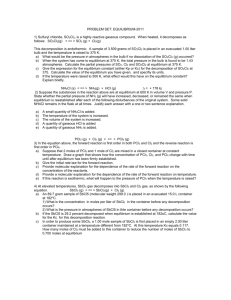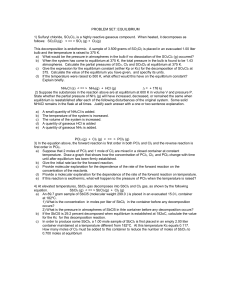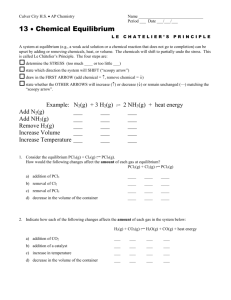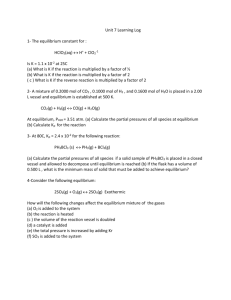Classwork
advertisement
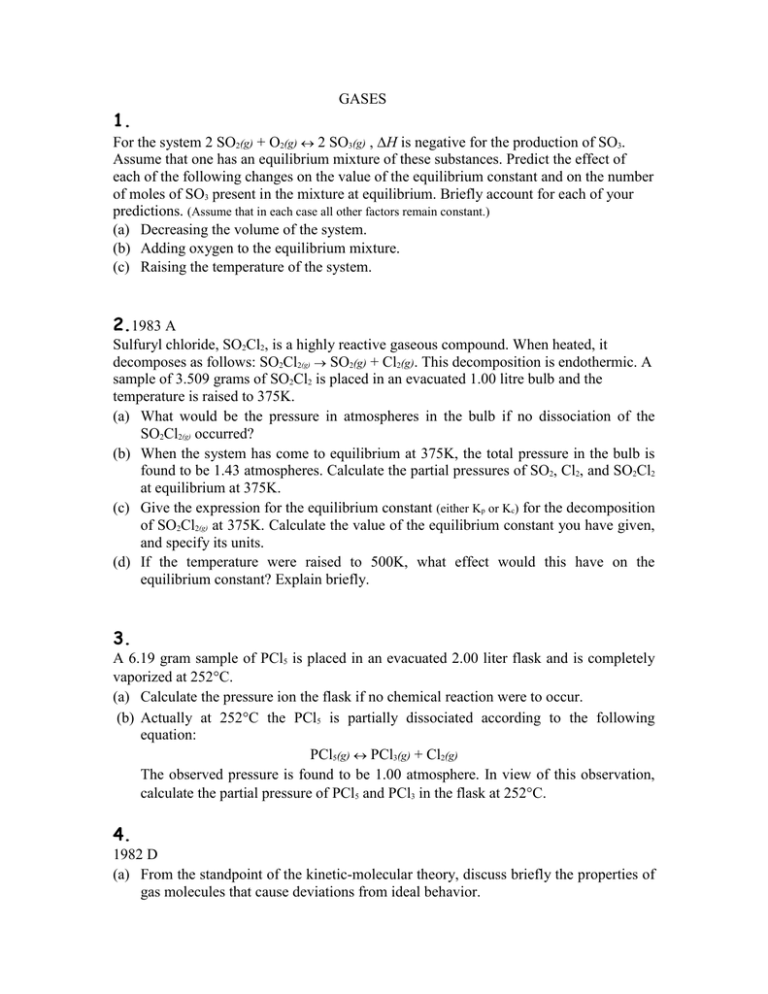
GASES 1. For the system 2 SO2(g) + O2(g) 2 SO3(g) , H is negative for the production of SO3. Assume that one has an equilibrium mixture of these substances. Predict the effect of each of the following changes on the value of the equilibrium constant and on the number of moles of SO3 present in the mixture at equilibrium. Briefly account for each of your predictions. (Assume that in each case all other factors remain constant.) (a) Decreasing the volume of the system. (b) Adding oxygen to the equilibrium mixture. (c) Raising the temperature of the system. 2.1983 A Sulfuryl chloride, SO2Cl2, is a highly reactive gaseous compound. When heated, it decomposes as follows: SO2Cl2(g) SO2(g) + Cl2(g). This decomposition is endothermic. A sample of 3.509 grams of SO2Cl2 is placed in an evacuated 1.00 litre bulb and the temperature is raised to 375K. (a) What would be the pressure in atmospheres in the bulb if no dissociation of the SO2Cl2(g) occurred? (b) When the system has come to equilibrium at 375K, the total pressure in the bulb is found to be 1.43 atmospheres. Calculate the partial pressures of SO2, Cl2, and SO2Cl2 at equilibrium at 375K. (c) Give the expression for the equilibrium constant (either Kp or Kc) for the decomposition of SO2Cl2(g) at 375K. Calculate the value of the equilibrium constant you have given, and specify its units. (d) If the temperature were raised to 500K, what effect would this have on the equilibrium constant? Explain briefly. 3. A 6.19 gram sample of PCl5 is placed in an evacuated 2.00 liter flask and is completely vaporized at 252C. (a) Calculate the pressure ion the flask if no chemical reaction were to occur. (b) Actually at 252C the PCl5 is partially dissociated according to the following equation: PCl5(g) PCl3(g) + Cl2(g) The observed pressure is found to be 1.00 atmosphere. In view of this observation, calculate the partial pressure of PCl5 and PCl3 in the flask at 252C. 4. 1982 D (a) From the standpoint of the kinetic-molecular theory, discuss briefly the properties of gas molecules that cause deviations from ideal behavior. (b) At 25C and 1 atmosphere pressure, which of the following gases shows the greatest deviation from ideal behavior? Give two reasons for your choice. CH4 SO2 O2 H2 (c) Real gases approach ideality at low pressure, high temperature, or both. Explain these observations. 5. 1988 A At elevated temperatures, SbCl5 gas decomposes into SbCl3 gas and Cl2 gas as shown by the following equation: SbCl5(g) SbCl3(g) + Cl2(g) (a) An 89.7 gram sample of SbCl5 (molecular weight 299.0) is placed in an evacuated 15.0 litre container at 182ºC. 1. What is the concentration in moles per litre of SbCl5 in the container before any decomposition occurs? 2. What is the pressure in atmospheres of SbCl5 in the container before any decomposition occurs? (b) If the SbCl5 is 29.2 percent decomposed when equilibrium is established at 182ºC, calculate the value for either equilibrium constant Kp or Kc, for this decomposition reaction. Indicated whether you are calculating Kp or Kc. (c) In order to produce some SbCl5, a 1.00 mole sample of SbCl3 is first placed in an empty 2.00 litre container maintained at a temperature different from 182ºC. At this temperature, Kc, equals 0.117. How many moles of Cl2 must be added to this container to reduce the number of moles of SbCl3 to 0.700 mole at equilibrium? 6. 1982 D (a) From the standpoint of the kinetic-molecular theory, discuss briefly the properties of gas molecules that cause deviations from ideal behavior. (b) At 25C and 1 atmosphere pressure, which of the following gases shows the greatest deviation from ideal behavior? Give two reasons for your choice. CH4 SO2 O2 H2 (c) Real gases approach ideality at low pressure, high temperature, or both. Explain these observations. 7. 1994 B A student collected a sample of hydrogen gas by the displacement of water as shown by the diagram above. The relevant data are given in the following table. GAS SAMPLE DATA Volume of sample 90.0 mL Temperature 25C Atmospheric Pressure 745 mm Hg Equilibrium Vapor Pressure of H2O (25C) 23.8 mm Hg (a) Calculate the number of moles of hydrogen gas collected. (b) Calculate the number of molecules of water vapor in the sample of gas. (c) Calculate the ratio of the average speed of the hydrogen molecules to the average speed of the water vapor molecules in the sample. (d) Which of the two gases, H2 or H2O, deviates more from ideal behavior? Explain your answer. 8. Represented above are five identical balloons, each filled to the same volume at 25C and 1.0 atmosphere pressure with the pure gases indicated. (a) Which balloon contains the greatest mass of gas? Explain. (b) Compare the average kinetic energies of the gas molecules in the balloons. Explain. (c) Which balloon contains the gas that would be expected to deviate most from the behavior of an ideal gas? Explain. (d) Twelve hours after being filled, all the balloons have decreased in size. Predict which balloon will be the smallest. Explain your reasoning. 9. 1998 D C(s) + H2O(g) CO(g) + H2(g) Hº = +131kJ A rigid container holds a mixture of graphite pellets (C(s)), H2O(g), CO(g), and H2(g) at equilibrium. State whether the number of moles of CO(g) in the container will increase, decrease, or remain the same after each of the following disturbances is applied to the original mixture. For each case, assume that all other variables remain constant except for the given disturbance. Explain each answer with a short statement. (a) Additional H2(g) is added to the equilibrium mixture at constant volume. (b) The temperature of the equilibrium mixture is increased at constant volume. (c) The volume of the container is decreased at constant temperature. (d) The graphite pellets are pulverized.
